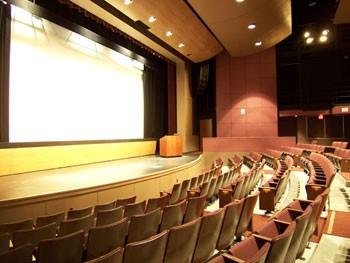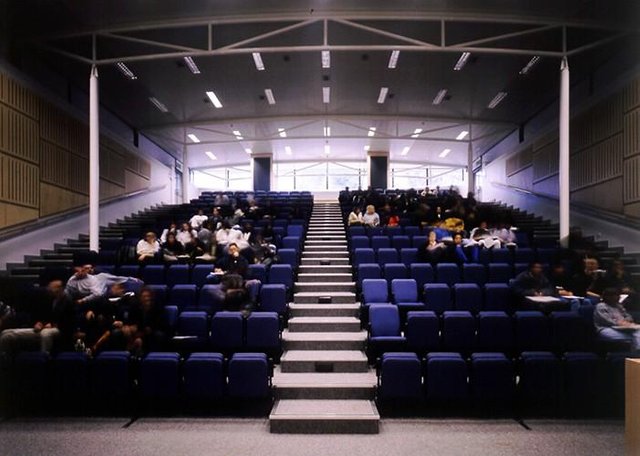Ultra modern lecture theatre design
Lecture Theatre
A large room typically used for instruction, lecture theatres differ from that
of the traditional classroom or other learning spaces. The lecture theatre
design is based on that of the auditorium, designed for an audience and
performer relationship, providing spectators with excellent visibility of the
main stage or platform. Most lecture theatres are installed with tiered
seating, enabling those sitting right at the back to be able to see what is
happening at the front.
Tiered seating lecture hall
Lecture theatres can be used for the following purposes:
Teaching and presenting
Performances
Staff meetings
Drama classes
Interactive learning and discussion
Why Lecture Theatre Design Is Important
The design of a lecture theatre has a significant influence on the learning
experience, it should be optimised for creating an environment which
stimulates concentration and interaction. A badly designed lecture theatre
does the opposite of encouraging learning, causing even the most attentive
of students to lose focus during the lecture. Obviously, the quality of the
audio-visual material itself is important, but this is of no benefit unless the
theatre stimulates absorption.
Lecture theatre design must incorporate a number of features in order to provide optimum studying conditions.
Design Considerations
Visibility/Sightlines
This is vital to the success of any lecture theatre, every member of the audience should be able to see clearly at all times with an unobstructed sight line, they should also be physically close enough to be able to recognise the facial expression of the person(s) presenting. The success of any lecture or presentation largely depends on the relationship of the audience to the performer.
Lecture Theatre Seating
The distribution of seating is paramount to audience participation and interactive learning, including how seats relate to each other, as well as the stage. Lecture theatre seating is usually arranged in sloping tiers so that spectators can see over the heads of those in front.The use of tiered seating arrangements dates back as far as the ancient Greeks and is the most common form of seating in auditoriums and
stadiums. Seats are often curved at an angle allowing spectators to view
the stage as well as each other. By providing rows of seats which rotate
360°, students are able to participate more easily in interactive learning,
facilitating group work and collaborative study.
students studying
The seats themselves should provide adequate legroom and be
comfortable to sit on for long periods, sitting on an uncomfortable seat
causes the occupant to focus on his or her discomfort rather than the
lecture at hand – comfort correlates productivity.
Desk Space
Spectators must not only feel comfortable in their seats, but be able to write easily without being cramped and restricted. There are many different types of writing tablets available on the market, the A3 writing tablet however, is suitable for both left and right-handed users, allowing users to increase and
maximise their learning potential.
Structural Tiering
This refers to the platform on which the seating is secured to, it may also be referred to as stepping, risers or raking. Superior quality structural tiering ismade from a steel frame with a timber deck – this form of tiering allows the creation of perfect sightlines in any lecture theatre. Structural tiering can be adapted to fit different spaces, it should not however be too high in the lecture theatre, as this may be unsettling for the audience. 
Image Source
Natural Illumination
Natural lighting increases productivity and comfort levels for occupants in any space. Unfortunately, designers often exclude the use of natural light as
it can cause other problems such as heat, glare and distraction. 
Acoustics
Any room with poor acoustics will hinder
comprehension and ultimately concentration levels. Many lecture halls, especially the larger ones are noisy, sound bounces off hard surfaces causing echoes forcing the brain to strain more in order to understand the sound. Most modern lecture theatre
design incorporates acoustic panelling.
Ventilation
All large rooms and buildings intended for gatherings will need careful design for ventilation, air change rate and air conditioning. Regulations stipulate that each occupant must be supplied with a minimum quantity of fresh air per second. Sitting in an overly warm and stuffy lecture theatre will stimulate tiredness rather than concentration as the audience will unlikely to be able to concentrate.
Other Points
Wheelchair access, fire protection and easy access to fire escapes are also all essential to the planning of lecture theatre design.
Hi! I am a robot. I just upvoted you! I found similar content that readers might be interested in:
http://www.fercoseating.com/news/latest-news/lecture-theatre-design/